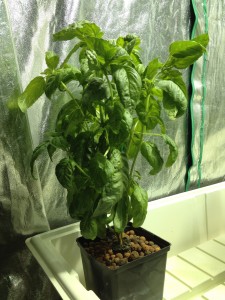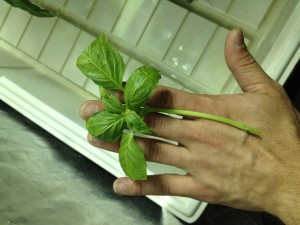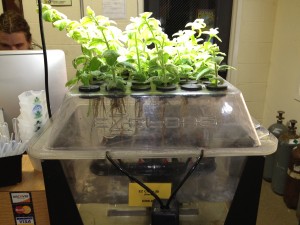Whether you are looking to get an extra harvest out of your indoor garden each year, or have a high yielding plant that you want to perpetuate indefinitely, learning how to root stem cuttings can help you out immensely.

The best way to have a steady supply of cuttings is to grow a donor or ‘mother’ plant that is kept in a vegetative state. You want your donor plant to be as healthy as possible with many nodes from which to cut clones to minimize stress as you shear off pieces of the plant. At the time of clone taking the donor plant should be fully turgid (well watered) as dehydration is the most pressing problem a clone faces. Once you are ready to start, the process can be broken down into three easy steps:
1. Make an initial cut on a side branch about 6 inches long. Place this cutting underwater and then make a second cut about 2-3 inches in from the end of the cutting. This prevents an embolism, or air bubble, from entering the tissue inside the cutting. As in people, embolisms can do serious damage or even kill a clone.
2. Quickly dip the clone into rooting gel and place into the rooting medium of your choice. We have several gels including RootTech, Clonex, and Olivia’s, all of which work well. Rooting gels are more efficient to use than powders because they stick to the end of the clone instead of rinsing off when watered and help prevent embolisms by ‘capping’ the wound. The active ingredient in RootTech and Clonex rooting gels is known as IBA- a hormone that induces adventitious root formation. Common cloning media are similar to those discussed in the seed starting post: peat plugs, rockwool, and mild-nutrient soils. Peat plugs and rockwool tend to be preferred as you can see root development as it happens, instead of gently tugging a plant in soil to see if it has anchored itself.

Note: Be sure not to dip clones directly into your bottle of gel; you can easily contaminate your entire supply with pathogenic microbes. Instead, pour an ample amount of gel out onto wax paper or the like.
3. Maintain a high level of humidity around the clones with a Mondi Humidome flat tray cover to minimize moisture loss through transpiration. Also, if there are large leaves on the cutting, cut these in half to decrease transpiration.
If you are taking many clones on a regular basis, you may want to invest in a hydroponic cloning system, which often has higher success rates and achieves rooting more quickly. With a hydroponic system, you don’t need any media in which to plant the cutting before it is rooted, saving money and resources. Clones made in a hydroponic system can be utilized in a hydroponic system for their full life cycle or planted in soil. The two most popular systems are bubble cloners and aeroponic cloners. The process for taking clones is the same as previously discussed although you don’t necessarily need to use cloning gel.
Bubble cloners are very easy to make with a 3 or 5 gallon bucket, air pump and stone, 2 inch net cups and neoprene collars. These require that you maintain a water level just under the bottom of the net cups so that the stems are kept moist.

Aeroponic cloning machines, although a bigger investment, are the easiest, most fool-proof and efficient way to clone. We use Diamond Black, a humic acid supplement made by General Organics and Rapid Start by General Hydroponics in the water reservoir. The success rate with these cloners is virtually 100%. Roots are often visible in 8 to 10 days and as few as 5 in the case of basil. From the EZ Clone, rooted cuttings can be transplanted into soil, a soilless medium or a hydroponic medium.
Note: it is important to maintain the cleanliness of your cloning system to prevent bacteria and fungi from rotting your clone’s stems. To clean between uses run H2O2 through the system for a couple of hours. For more persistent build up, use a brush and a dilute H2O2 or bleach solution. To make sure no microorganisms remain in the system, run Flora Shield with your nutrient water.
To recap, providing clones with optimal conditions goes a long way toward minimizing stress so they can root abundantly. Make sure your 3-6 inch cuttings have few (if any) large leaves, maintain temperatures close to 72 degrees and provide 60-80% relative humidity. To initiate and hasten root development, use cloning gels that contain micro nutrients with the IBA hormone. To maximize your success rate, water your cuttings with a light liquid fertilizer like Rapid Start, which is designed specifically for seedlings and clones.
By Chase Werner

Nick says
None of those products are organic. Not even the general organics brand.
However organic honey works as a rooting hormone. Cinnamon as well.
I’ve tried both with success. More so with the honey than the cinnamon.
Try mixing 1-3 Tbs of honey per gallon of RO water. Don’t worry about the ph for clones. But if you do, wood ash is a good organic ph up and lemon juice is a good ph down. I trim back leaves to focus the energy on the roots. But this WILL cause the leaves to dry out if you don’t have a dome or you don’t most daily.
Hope I helped 🙂
Brandon Colman says
Nick, thanks for chiming in. It’s true, we didn’t feature any organic approved products in this particular post. When cloning all but the easiest-rooting clones, we need a hormone that honey and cinnamon won’t offer. Making a tea out of willow bark, which is high in rooting hormone, is an age old, tried and true option. As far as pH goes, we are interested in maintaining a range that maximizes solubility of the most essential plant nutrients- though its true, that’s probably the icing rather than the cake as far as cloning success goes.
Edyn Garvisch says
I’m curious, what plants can easily be cloned to see results within about a week or less time?
Brandon Colman says
We have found sweet basil to clone incredibly easily and typically well within the time frame you mentioned. Basil plants also produce profuse branching from which many clones can be harvested. Best luck!
Jeff Davies says
Do you ever need to trim the neoprene collars to make the opening bigger as the plant grows? I’m growing bibb, romaine and arugula and it seems like they are all getting a little choked off because of the neoprene collar. Yet I have never heard anyone mentioning having to trim them. Does lettuce have a weaker stem than basil and other plants that are traditionally grown hydroponically?
Caretaker says
All very appreciated information thank you all. My question is, has anyone used willow water ONLY in a clone machine? or perhaps a ratio mixed w/distilled water?